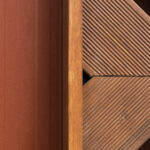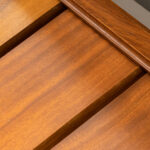
Are you tired of the same old look of your home? Do you want to give it a fresh new look without spending a fortune on renovations? If yes, then veneer laminated plywood might just be the solution for you. Veneer laminated plywood is an engineered wood product that is widely used in home renovation due to its durability, versatility, and cost-effectiveness. In this article, we will guide you on how to transform your home with veneer-laminated plywood.
What is Veneer Laminated Plywood?
Veneer laminated plywood is a type of engineered wood that is made up of thin sheets of wood veneer that are glued together to form a strong and durable plywood panel. The top layer of the plywood is made from a high-quality, real wood veneer that is carefully selected for its aesthetic appeal and durability.
How is Veneer Laminated Plywood Made?
The process of making veneer laminated plywood involves several steps.
Here are the steps involved in the process of making veneer laminated plywood in more detail:
- Wood veneer selection: The first step is selecting high-quality wood veneers based on the desired appearance, strength, and durability.
- Slicing: The selected veneer is then sliced into thin sheets using a rotary cutting machine or a slicing machine.
- Drying: The veneer sheets are dried to remove any excess moisture, preventing the warping or splitting of the finished product.
- Gluing: The dried veneer sheets are glued together using a strong adhesive, applied evenly to each layer.
- Stacking: The glued veneer sheets are stacked on top of each other to form a panel, with the number of layers used depending on the desired thickness of the finished plywood.
- Pressing: The stacked veneer panels are pressed under high pressure and heat to bond the layers of the veneer together and ensure a flat, smooth finished product.
- Trimming: After pressing, excess veneer around the edges is trimmed off using a saw or trimming machine.
- Sanding: The edges of the plywood are sanded to ensure they are smooth and uniform in thickness.
- Finishing: The finished plywood may be stained or coated with a protective finish to enhance its appearance and durability.
Overall, the process of making veneer laminated plywood involves a careful selection of high-quality veneer, precision slicing, gluing, pressing, trimming, sanding, and finishing to create a strong and durable product that is ideal for a variety of applications.
Types of Veneer Laminated Plywood
There are several types of veneer laminated plywood, each with its own unique characteristics and uses.
Some of the most common types include:
Hardwood Plywood
Hardwood plywood is made from hardwood veneer and is known for its strength, durability, and beautiful grain patterns. It is commonly used for furniture making, cabinetry, and architectural millwork.
Softwood Plywood
Manufacturers make softwood plywood by using softwood veneers, such as pine or cedar, which makes it a more cost-effective option than hardwood plywood. Softwood plywood finds common applications in sheathing, roofing, and subfloors.
Marine Plywood
Manufacturers design marine plywood for use in wet environments, such as boat building and exterior construction. They make it with a special adhesive that resists water, and it usually costs more than other types of plywood.
Structural Plywood
Manufacturers design structural plywood specifically for use in structural applications like framing and sheathing, using a high-grade adhesive that ensures superior strength and stability.
Advantages of Veneer Laminated Plywood

It is a versatile and durable building material that offers many advantages over traditional solid wood and other composite materials.
Here are some of the main advantages of using veneer laminated plywood to Transform Your Home:
Aesthetics
One of the major benefits of veneer laminated plywood is its aesthetic appeal. Veneer laminated plywood is available in a variety of wood species, grain patterns, and finishes. This makes it easy to match with any interior design theme.
Durability
Veneer laminated plywood is known for its durability. It is resistant to wear and tear, moisture, and termites. This makes it a great choice for areas of high traffic, such as flooring and furniture.
Cost-effectiveness
Compared to solid wood, veneer laminated plywood is more cost-effective. It is also easier to work with, which reduces installation costs.
Easy maintenance
Veneer laminated plywood is easy to maintain. Regular cleaning with a damp cloth is sufficient to keep the surface clean. Furthermore, repairing it is easy in case of any damage.
Areas of Application of Veneer Laminated plywood
You can use it in various areas of your home. Some of the popular Areas of Application of Veneer laminated plywood to Transform Your Home include:
Walls and ceilings
You can use this ply to add warmth and texture to walls and ceilings. You can install it as panels or planks.
Furniture
You can use it for making furniture, such as tables, chairs, and cabinets. Its durability and aesthetic appeal make it a popular choice.
Flooring
You can use this plywood as a flooring material. It is a cost-effective alternative to solid wood flooring and is available in a variety of finishes and patterns.
Kitchen cabinets
It is a popular choice for kitchen cabinets due to its durability and ease of maintenance.
Doors and windows
You can use this ply for making doors and windows. Its moisture resistance makes it suitable for use in areas with high humidity levels.
How to Choose the Right Veneer Laminated Plywood & Transform Your Home
When choosing veneer laminated plywood for your home renovation, there are a few factors to consider:
Purpose
Consider the purpose for which you are using the plywood. This will help you choose the right type, grade, and thickness.
Quality of the plywood
Make sure to choose high-quality plywood. Look for plywood that has a smooth and even surface and no visible defects.
Plywood grade
The grade of the plywood will determine its quality and appearance. Plywood grades range from A to D, with A being the highest quality.
Grain pattern
Choose a grain pattern that matches the interior design theme of your home. Some popular grain patterns include oak, maple, and cherry.
Preparing for Veneer Laminated Plywood Installation
Before installing laminated veneer plywood, it’s important to prepare the space properly. Follow these steps:
Measuring the space
Measure the space accurately to determine how much plywood you will need. Add a few extra sheets to account for wastage.
Surface Preparation
Ensure that you clean, smooth, and free the surface where you will install the plywood from any debris. If necessary, apply a primer or sealer to the surface.
Preparing the plywood
Before installation, acclimate the plywood to the room’s temperature and humidity. This will prevent any warping or buckling after installation.
Installation Process
The installation process for veneer laminated plywood can vary depending on the application and the specific product used.
However, the installation process commonly involves the following general steps:
- Preparation: Before installing, it is important to properly prepare the surface that it will be attached to. This may involve sanding or leveling the surface, applying adhesive or other bonding agents, or priming the surface to ensure good adhesion.
- Cutting and sizing: Typically, people cut and size it to fit the specific application. This may involve cutting the material to the desired shape or size using saws or other cutting tools.
- Fastening: After cutting and sizing the plywood, users fasten it to the surface with screws, nails, or adhesives, depending on the product and application requirements.
- Finishing: To achieve the desired aesthetic effect, one may need to finish the plywood after installation. This may involve sanding, staining, painting, or sealing the material to protect it from moisture, UV rays, or other environmental factors.
- Clean-up: Once the installation and finishing processes are complete, it is important to clean up any debris or waste materials from the work site. During the installation process, the installer may need to dispose of sawdust, excess adhesive, or other materials that the process generated.
Maintenance and Cleaning
Proper maintenance and cleaning are important to ensure the longevity and appearance of veneer-laminated plywood.
Here are some tips for maintaining and cleaning this plywood:
- Avoid direct sunlight: Direct sunlight can cause the plywood to fade or discolour over time. Avoid exposing the material to direct sunlight for prolonged periods by placing it in shaded areas.
- Clean spills promptly: Wipe up any spills or stains on the surface of the plywood as soon as possible. Use a clean, damp cloth to wipe away any liquid, then dry the surface thoroughly with a dry cloth.
- Use mild detergents: When cleaning the surface of plywood, use a mild detergent and water solution. Avoid using abrasive cleaners or scouring pads, which can scratch or damage the surface.
- Avoid harsh chemicals: Harsh chemicals such as bleach or ammonia can damage the surface of plywood. Avoid using these types of cleaners on the material.
- Use furniture wax: Apply furniture wax or polish to the surface of plywood to protect the surface and enhance its natural beauty. Be sure to follow the manufacturer’s instructions for the product you are using.
- Avoid excess moisture: Excess moisture can cause the plywood to warp or delaminate. Avoid exposing the material to high levels of humidity or moisture, and use a dehumidifier in areas where humidity levels are high.
- Inspect regularly: Regularly inspect the plywood for signs of damage or wear. Repair any scratches, chips, or other damage as soon as possible to prevent further damage and maintain the appearance of the material.
By following these simple maintenance and cleaning tips, you can ensure the longevity and appearance of this plywood. With proper care, this versatile and durable material can provide years of reliable performance and aesthetic appeal.
FAQs
Yes, You can use a vacuum cleaner with a soft brush attachment to remove dust and debris from the surface of veneer-laminated plywood. Be sure to avoid using a vacuum cleaner with a beater bar or hard-bristled brush, as this can cause scratches or damage to the surface.
The frequency of cleaning will depend on how heavily the material is used, but it is generally recommended to clean it at least once a month.
Use a mild detergent and water solution and a soft cloth to gently rub the stain away. You may require a specialized cleaning product for tougher stains. Be sure to test any cleaning product on a small, inconspicuous area of the surface before using it on the entire surface.
Avoid placing sharp objects or heavy items directly on the surface of the material. Use coasters or placemats to protect the surface from scratches and dents.
Use a wood filler or touch-up paint to fill in the damaged area. Be sure to match the colour and finish of the original material as closely as possible. Allow the filler or paint to dry completely before sanding and buffing the surface to a smooth finish.
Refinishing this plywood is not recommended as it can cause damage to the surface. Sanding away the thin layer of veneer on top of the plywood can easily expose the underlying layers.
Conclusion
We have covered a detailed guide on How to Transform Your Home with Veneer Laminated Plywood. This plywood is a versatile and cost-effective material that can transform your home’s appearance. Whether you’re looking to add warmth and texture to your walls and ceilings, create durable and attractive furniture, or install cost-effective flooring, this plywood is an excellent choice. By considering factors such as purpose, quality, grade, and grain pattern and following proper installation and maintenance procedures, you can ensure that your veneer laminated plywood will look beautiful and last for years to come.



